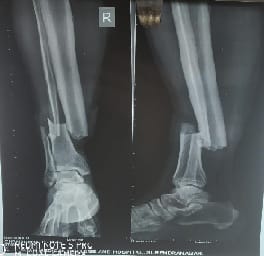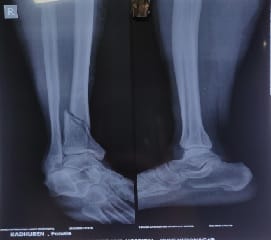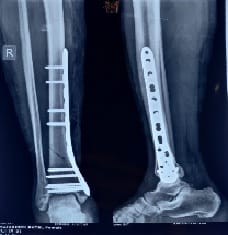Comparison of clinical, radiological, and functional outcome of closed fracture of distal third tibia treated with nailing and plate osteosynthesis
Vora J.1, Jetpariya D.2*, Desai K.3
DOI: https://doi.org/10.17511/ijoso.2020.i05.02
1 Jinesh Vora, Associate Professor, C.U Shah Medical College and Hospital, Surendranagar, Gujarat, India.
2* Divyesh Jetpariya, Postgraduate Student, C.U Shah Medical College and Hospital, Surendranagar, Gujarat, India.
3 Kabir Desai, Senior Resident, C.U Shah Medical College and Hospital, Surendranagar, Gujarat, India.
Aim: This is a prospective study of 30 patients with distal tibia fracture (Closed extra-articular distal third tibia fractures - 4 to 11cm from tibial plafond) who underwent surgical fixation were included in this study after excluding compound, pathological and pediatric fractures. Materials and Methods: 15 underwent closed intramedullary interlocking nail and 15 were treated with plate osteosynthesis (MIPO). Results: The age distribution ranged from 23 to 68 years with the mean age of 39.4 years. The mode of injury in all patients was due to vehicle accidents. All 30 patients were classified according to AO classification of which 15 belonged to A1, 14 belonged to A2, and 1 belonged to A3. The time of fixation from injury varied from 6 hours to 18 days. Conclusion: Plate osteosynthesis by minimally invasive technique and Intramedullary interlocking nailing is an equally effective method of stabilization for distal tibia fracture when considering the union rates and final functional outcome. However, malunion, nonunion and secondary procedures were more frequent after intramedullary interlocking nail. In MIPO platting Infection followed by an exposed plate occurs in 2 patients. Randomized prospective evaluation of distal tibia fractures may clarify the efficacy of plate versus nail treatment and optimize patient care.
Keywords: Distal tibial locking plate, Tibial nailing, MIPPO
| Corresponding Author | How to Cite this Article | To Browse |
|---|---|---|
| , Postgraduate Student, C.U Shah Medical College and Hospital, Surendranagar, Gujarat, India. Email: |
Vora J, Jetpariya D, Desai K. Comparison of clinical, radiological, and functional outcome of closed fracture of distal third tibia treated with nailing and plate osteosynthesis. Surgical Rev Int J Surg Trauma Orthoped. 2020;6(5):298-304. Available From https://surgical.medresearch.in/index.php/ijoso/article/view/199 |


 ©
© 


